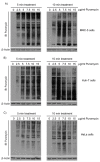Quantitative Immunofluorescence to Measure Global Localized Translation
- PMID: 28872115
- PMCID: PMC5614359
- DOI: 10.3791/55909
Quantitative Immunofluorescence to Measure Global Localized Translation
Abstract
The mechanisms regulating mRNA translation are involved in various biological processes, such as germ line development, cell differentiation, and organogenesis, as well as in multiple diseases. Numerous publications have convincingly shown that specific mechanisms tightly regulate mRNA translation. Increased interest in the translation-induced regulation of protein expression has led to the development of novel methods to study and follow de novo protein synthesis in cellulo. However, most of these methods are complex, making them costly and often limiting the number of mRNA targets that can be studied. This manuscript proposes a method that requires only basic reagents and a confocal fluorescence imaging system to measure and visualize the changes in mRNA translation that occur in any cell line under various conditions. This method was recently used to show localized translation in the subcellular structures of adherent cells over a short period of time, thus offering the possibility of visualizing de novo translation for a short period during a variety of biological processes or of validating changes in translational activity in response to specific stimuli.
References
-
- Morisaki T, et al. Real-time quantification of single RNA translation dynamics in living cells. Science. 2016;352:1425–1429. - PubMed
-
- Halstead JM, et al. TRICK: A Single-Molecule Method for Imaging the First Round of Translation in Living Cells and Animals. Methods Enzymol. 2016;572:123–157. - PubMed
-
- Bergeman J, Caillier A, Houle F, Gagne LM, Huot ME. Localized translation regulates cell adhesion and transendothelial migration. J Cell Sci. 2016;129:4105–4117. - PubMed
Publication types
MeSH terms
Grants and funding
LinkOut - more resources
Full Text Sources
Other Literature Sources






